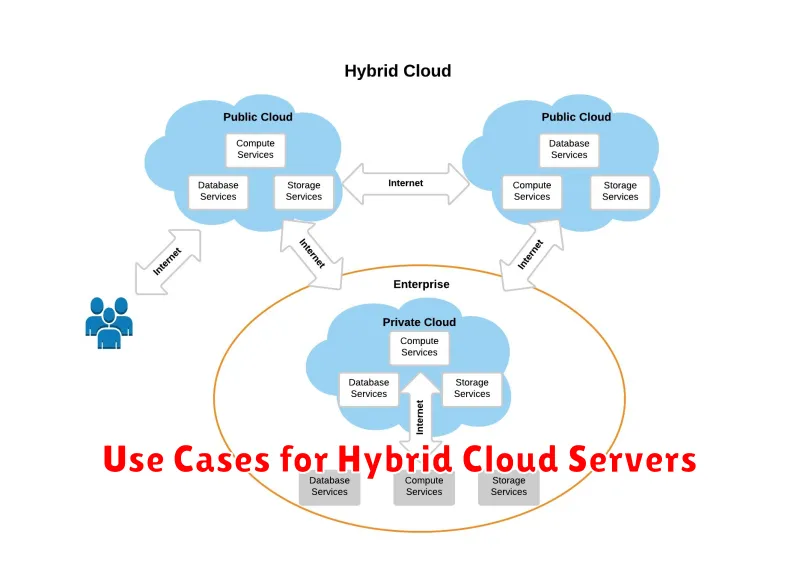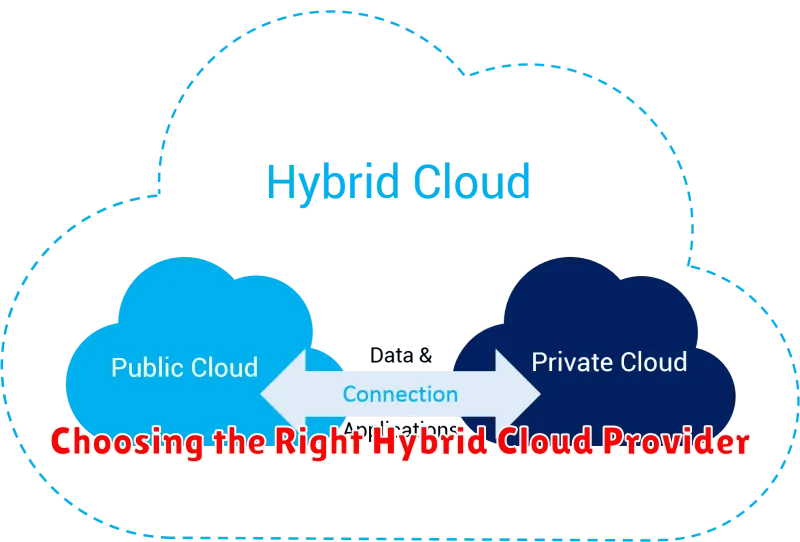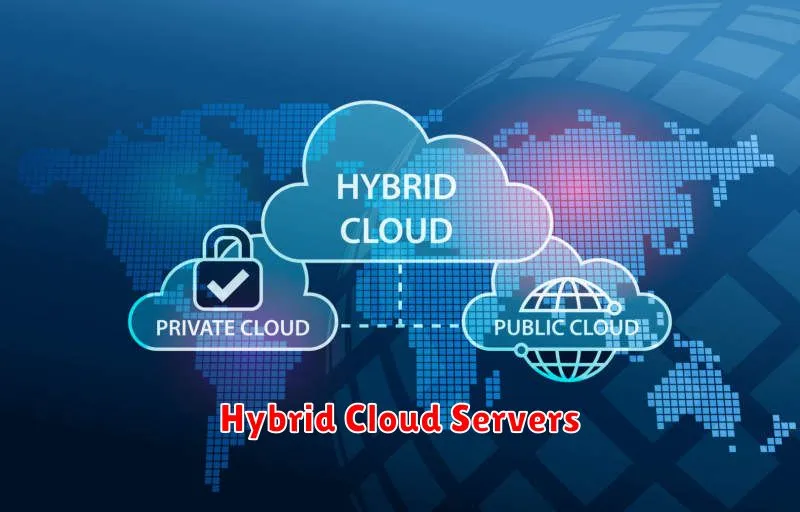Are you looking for a way to boost your business efficiency and scalability without breaking the bank? Hybrid cloud servers offer the perfect solution. By combining the best of both worlds – the flexibility and cost-effectiveness of the cloud with the security and control of your on-premises infrastructure – hybrid cloud servers allow you to optimize your IT resources for peak performance. This article will delve into the key benefits of using hybrid cloud servers for your business, exploring how they can enhance your operations, drive innovation, and ultimately, propel your success.
Understanding Hybrid Cloud Servers
In today’s digital landscape, businesses are constantly seeking ways to optimize their infrastructure and enhance their IT operations. Hybrid cloud servers have emerged as a popular solution, offering a blend of flexibility, scalability, and cost-effectiveness. This article delves into the intricacies of hybrid cloud servers, exploring their benefits, drawbacks, and key considerations.
What are Hybrid Cloud Servers?
Hybrid cloud servers represent a combination of on-premises infrastructure and cloud computing services. They enable businesses to leverage the advantages of both worlds, seamlessly integrating private and public cloud resources. In a hybrid cloud setup, critical applications and sensitive data can be hosted on-premises for enhanced security and control, while less critical workloads or those requiring burst capacity can be deployed in the cloud for flexibility and scalability.
Benefits of Hybrid Cloud Servers
Hybrid cloud servers offer a multitude of benefits for organizations, including:
- Flexibility and Scalability: The ability to easily scale resources up or down based on fluctuating demands is a key advantage of hybrid cloud servers. Businesses can leverage cloud resources for peak workloads, while retaining on-premises infrastructure for core operations.
- Cost-Effectiveness: By strategically allocating workloads between on-premises and cloud environments, businesses can optimize their IT expenses. They can pay for only the cloud resources they use, reducing capital expenditures on infrastructure.
- Improved Security: Hybrid cloud setups allow businesses to retain control over sensitive data and applications while leveraging cloud-based security measures for additional protection.
- Enhanced Reliability and Disaster Recovery: By replicating critical data and applications in the cloud, businesses can ensure business continuity in the event of on-premises disruptions.
Drawbacks of Hybrid Cloud Servers
While hybrid cloud servers offer numerous benefits, there are also some potential drawbacks to consider:
- Complexity: Managing a hybrid cloud environment can be more complex than managing either a purely on-premises or cloud-based infrastructure. It requires expertise in both on-premises and cloud technologies.
- Security Challenges: Ensuring seamless security across both on-premises and cloud environments can be a challenge, requiring careful planning and implementation.
- Vendor Lock-in: Depending on the specific cloud provider chosen, businesses may face vendor lock-in, making it difficult to switch to a different provider in the future.
Key Considerations for Hybrid Cloud Adoption
When considering a hybrid cloud strategy, businesses should carefully evaluate the following factors:
- Workloads: Identify the applications and workloads that are best suited for the cloud and those that should remain on-premises.
- Security: Determine the appropriate security measures for both on-premises and cloud environments, including access control, data encryption, and threat monitoring.
- Integration: Ensure seamless integration between on-premises and cloud resources to facilitate data sharing and application interoperability.
- Cost: Analyze the cost implications of migrating workloads to the cloud, including subscription fees, bandwidth charges, and potential infrastructure upgrades.
Conclusion
Hybrid cloud servers provide businesses with a flexible and cost-effective way to optimize their IT infrastructure. By leveraging the strengths of both on-premises and cloud environments, organizations can gain significant advantages in terms of scalability, security, and disaster recovery. However, it is crucial to carefully consider the potential drawbacks and key considerations before adopting a hybrid cloud strategy.
Benefits of Hybrid Cloud for Businesses
In today’s digital landscape, businesses are constantly seeking ways to enhance their operations and gain a competitive edge. Hybrid cloud, a combination of public and private cloud environments, has emerged as a powerful solution that offers numerous benefits for organizations of all sizes. By leveraging the best of both worlds, businesses can optimize their IT infrastructure, improve flexibility, and unlock new opportunities for growth.
Enhanced Flexibility and Scalability
One of the primary advantages of hybrid cloud is its unmatched flexibility and scalability. Businesses can seamlessly adjust their computing resources on demand, whether it’s for seasonal spikes in traffic or the launch of a new product. By using a combination of public and private cloud services, companies can scale up or down as needed, ensuring optimal resource utilization and cost efficiency.
Improved Cost Optimization
Hybrid cloud solutions can help businesses significantly reduce their IT costs. By leveraging public cloud services for non-critical workloads and keeping sensitive data in private cloud environments, organizations can optimize their spending. Public cloud services offer pay-as-you-go pricing models, while private clouds provide more control over costs and security. This balanced approach allows businesses to maximize cost savings without compromising on performance or security.
Enhanced Security and Compliance
Security is a paramount concern for businesses, and hybrid cloud provides a robust solution to address this challenge. By keeping sensitive data and critical applications within private cloud environments, companies can maintain tight control over security measures. Public cloud services can be leveraged for less sensitive workloads, offering a flexible and cost-effective approach to managing security risks. This combination of security measures allows businesses to achieve a balance between security and agility.
Improved Disaster Recovery and Business Continuity
Hybrid cloud solutions enhance disaster recovery capabilities and business continuity plans. By replicating critical data and applications across multiple cloud environments, businesses can ensure data availability and minimize downtime in the event of a disaster. Public cloud services can act as a backup and recovery site, while private clouds provide a secure and reliable primary environment. This redundancy ensures business continuity and minimizes disruptions to operations.
Increased Agility and Innovation
Hybrid cloud empowers businesses to be more agile and innovative. By providing access to a wide range of cloud services, businesses can quickly deploy new applications, experiment with emerging technologies, and bring new products and services to market faster. The flexibility and scalability of hybrid cloud enable organizations to adapt to changing market conditions and seize new opportunities.
Conclusion
Hybrid cloud offers a compelling solution for businesses seeking to optimize their IT infrastructure, enhance flexibility, and unlock new opportunities for growth. By leveraging the best of both public and private cloud environments, businesses can gain a competitive edge, improve efficiency, and drive innovation. As the cloud computing landscape continues to evolve, hybrid cloud is poised to become an essential tool for businesses of all sizes.
Enhanced Security and Compliance
In today’s digital landscape, data security and compliance are paramount. Organizations must implement robust security measures to protect sensitive information from unauthorized access, breaches, and cyberattacks.
Our enhanced security and compliance solutions are designed to help organizations meet the ever-evolving regulatory requirements and mitigate security risks. We offer a comprehensive suite of services, including:
- Threat Assessment and Vulnerability Scanning: Identifying potential weaknesses in your systems and applications to proactively address security vulnerabilities.
- Data Encryption and Access Control: Implementing strong encryption mechanisms to protect sensitive data at rest and in transit, along with granular access controls to limit unauthorized access.
- Security Awareness Training: Educating employees on best practices for cybersecurity, password management, and phishing prevention.
- Incident Response and Forensics: Providing rapid response to security incidents, conducting thorough investigations, and mitigating damage.
- Compliance Auditing and Certification: Helping organizations achieve compliance with industry-specific regulations and standards, such as HIPAA, GDPR, and PCI DSS.
Our team of security experts works closely with organizations to understand their unique requirements and develop customized solutions that meet their specific needs. We leverage industry-leading technologies and best practices to ensure that your data is secure and your organization is compliant.
By investing in enhanced security and compliance, organizations can:
- Protect sensitive information
- Reduce the risk of data breaches
- Enhance customer trust and confidence
- Maintain regulatory compliance
- Minimize operational downtime
Contact us today to learn more about our enhanced security and compliance solutions and how we can help your organization achieve its security and compliance goals.
Improved Scalability and Flexibility
The new system offers improved scalability and flexibility. It is designed to handle a large number of users and can be easily adapted to changing needs.
Cost Savings and Efficiency
In today’s competitive business environment, organizations are constantly seeking ways to reduce costs and improve efficiency. Cost savings and efficiency are two critical aspects of business success that can significantly impact profitability and overall performance. By streamlining operations, optimizing resource allocation, and implementing innovative solutions, businesses can unlock significant cost reductions and enhance their operational effectiveness.
Cost savings refer to the reduction of expenses incurred in various business activities. This can be achieved through a variety of strategies, including:
- Negotiating better prices with suppliers: Establishing strong relationships with suppliers and leveraging purchasing power can result in lower material and service costs.
- Optimizing inventory management: Implementing lean inventory management practices can reduce storage costs, minimize waste, and ensure timely delivery of goods.
- Automating processes: Automating repetitive tasks can free up employees for more strategic activities, leading to increased productivity and cost savings.
- Consolidating operations: Combining similar operations or departments can reduce overhead costs and improve efficiency.
Efficiency refers to the ability to perform tasks and processes effectively and productively. Businesses can enhance efficiency by:
- Improving communication and collaboration: Effective communication and collaboration among teams can streamline workflows and minimize delays.
- Implementing performance monitoring systems: Tracking key performance indicators (KPIs) allows businesses to identify areas for improvement and optimize processes.
- Investing in technology: Utilizing advanced technologies such as artificial intelligence (AI), machine learning (ML), and cloud computing can automate tasks, enhance decision-making, and improve operational efficiency.
- Empowering employees: Providing employees with the necessary training, tools, and resources can increase their productivity and engagement.
Achieving cost savings and efficiency is an ongoing process that requires continuous improvement. By prioritizing these goals and implementing effective strategies, businesses can create a more sustainable and profitable future.
` tag with a `
` heading that says “Seamless Integration with Existing Infrastructure”.** Once you provide the content, I’ll be happy to format it for you!
Use Cases for Hybrid Cloud Servers

Hybrid cloud servers offer a blend of on-premises and cloud infrastructure, providing organizations with the flexibility and scalability they need to meet their unique business needs. By combining the benefits of both environments, hybrid cloud servers can address a wide range of use cases, allowing businesses to optimize performance, reduce costs, and enhance agility.
1. Disaster Recovery and Business Continuity
Hybrid cloud servers play a vital role in disaster recovery and business continuity planning. By replicating critical data and applications to the cloud, organizations can ensure business operations continue uninterrupted in the event of a physical disaster or system failure. The cloud infrastructure acts as a backup, providing a secure and accessible environment to restore services quickly and minimize downtime.
2. Application Migration and Modernization
Hybrid cloud servers facilitate a gradual and controlled migration of legacy applications to the cloud. Organizations can move specific applications or workloads to the cloud while keeping others on-premises, allowing for a phased approach to modernization. This approach minimizes disruption to existing operations and reduces the risk associated with large-scale migrations.
3. Peak Load Handling and Scalability
Hybrid cloud servers enable organizations to handle sudden spikes in demand or seasonal fluctuations. By leveraging the elastic nature of cloud resources, businesses can scale up their infrastructure on demand to accommodate increased workloads. This flexibility ensures optimal performance during peak periods without the need for significant upfront investments in on-premises hardware.
4. Cost Optimization and Resource Management
Hybrid cloud servers offer cost-effective solutions for managing IT resources. Organizations can choose the most appropriate environment for different applications and workloads, optimizing resource utilization and reducing overall costs. By leveraging cloud services for specific needs, businesses can avoid the expenses associated with maintaining and managing their own on-premises infrastructure.
5. Data Analytics and Big Data Processing
Hybrid cloud servers provide a powerful platform for data analytics and big data processing. By combining the processing power of on-premises infrastructure with the scalability and flexibility of the cloud, organizations can analyze large datasets efficiently and gain valuable insights. This enables data-driven decision-making and improved business outcomes.
6. Application Development and Testing
Hybrid cloud servers create a flexible and agile environment for application development and testing. Developers can leverage cloud resources for prototyping, testing, and deployment, reducing development cycles and accelerating time to market. The ability to access on-premises infrastructure for specific needs further enhances the development process.
Choosing the Right Hybrid Cloud Provider

In today’s dynamic digital landscape, businesses are increasingly turning to hybrid cloud solutions to optimize their IT infrastructure and leverage the best of both worlds: the flexibility and scalability of the public cloud and the security and control of on-premises infrastructure. However, navigating the complex world of hybrid cloud providers can be daunting, requiring careful consideration of various factors to choose the best fit for your specific needs.
Key Considerations for Choosing a Hybrid Cloud Provider
When selecting a hybrid cloud provider, it’s crucial to evaluate the following aspects:
- Services and Features: Assess the range of services offered, including compute, storage, networking, security, and management tools. Ensure they align with your existing infrastructure and future requirements.
- Scalability and Flexibility: Determine the provider’s capacity to scale resources up or down based on your fluctuating demands. This ensures seamless adaptability to business growth or seasonal changes.
- Security and Compliance: Prioritize providers with robust security measures, data encryption, and compliance certifications (e.g., HIPAA, PCI DSS) relevant to your industry and data sensitivity.
- Integration Capabilities: Look for providers that seamlessly integrate with your existing systems and applications, minimizing complexity and ensuring smooth data flow.
- Cost and Pricing Models: Analyze the pricing structure, including usage-based billing, subscription models, and potential hidden costs. Opt for transparent and predictable pricing to manage your budget effectively.
- Support and Expertise: Evaluate the provider’s technical support, documentation, and knowledge base to ensure prompt assistance and guidance when needed.
Choosing the Right Provider: A Comprehensive Approach
The process of selecting a hybrid cloud provider requires a comprehensive approach that involves:
- Defining Your Requirements: Clearly articulate your business goals, application requirements, and desired outcomes. This lays the foundation for evaluating providers effectively.
- Research and Evaluation: Thoroughly research potential providers, comparing their offerings, pricing, and customer reviews. Request demos and conduct pilot projects to assess their suitability.
- Negotiation and Contract Review: Carefully review the terms and conditions of the agreement, ensuring clarity on service levels, responsibilities, and pricing.
- Pilot Implementation: Consider a phased rollout, starting with a pilot project to validate the provider’s capabilities and minimize risks.
Conclusion: A Strategic Investment in Your Future
Choosing the right hybrid cloud provider is a strategic decision that can significantly impact your business agility, scalability, and cost-effectiveness. By meticulously evaluating factors like services, security, integration, and support, you can select a provider that aligns with your unique needs and drives your digital transformation initiatives forward.
